Orange-flowering shrubs are a wonderful accent to any landscape garden. Orange-flowering shrubs are easy to grow, drought-tolerant, and do well in full sun or partial shade. Gorgeous orange blossoms look great against the rich green foliage.
Orange shrubs work well as borders, specimen plants, or foundation plantings. Furthermore, bees and butterflies are drawn to the vivid orange flowers. We examine our favourites in more detail in this post, complete with descriptions and images!
1. Witch Hazel
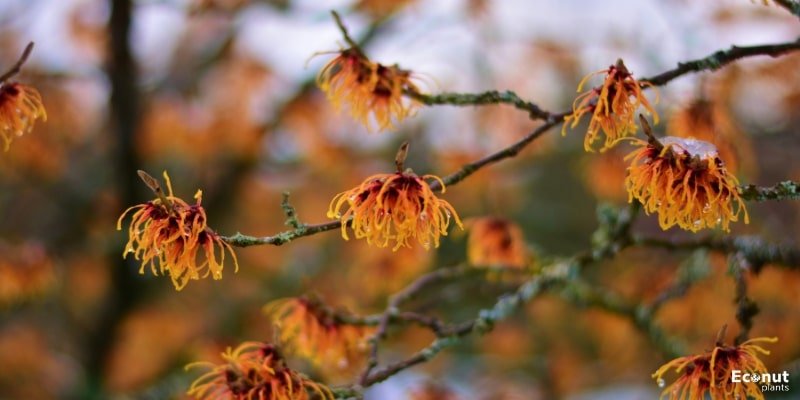
Scientific Name: Hamamelis
Plant Type: Evergreen shrub
Plant Size: 8-12 feet tall
Sun Exposure: Partial sun
One-of-a-kind shrub, witch hazel blooms in colder areas, usually from mid- to late-winter. Their creations are colourful, with tones of orange, red, and gold. Compared to shrubs that require full sun, these are a little more tolerant of partial shade.
A distinctive feature of some of the cultivars is their pungent aroma. The leaves may also become a deep shade of orange, yellow, or red in the autumn. This shrub prefers somewhat acidic or clayey soil, but it is not very particular about soil types. In warm climates, witch hazel can also grow.
2. Pomegranate

Scientific Name: Punica granatum
Plant Type: Shrub
Plant Size: 3-30 feet tall and wide
Sun Exposure: Full sun
Pomegranates are most commonly known for their delicious fruit, but they can also provide deep orange-red flowers when they bloom before the fruit-bearing season. The tubular form of the flowers is ideal for our hummingbird companions. If you don’t have enough room for the shrub, many botanists advise decreasing the plant to a bonsai tree for aesthetic reasons.
When planting this shrub, make sure the soil isn’t always wet, since it could lead to root rot. Although pomegranate bushes may withstand some cold, it’s important to find out in advance if you can grow them in your zone to prevent them from dying throughout the winter.
3. Orange Storm
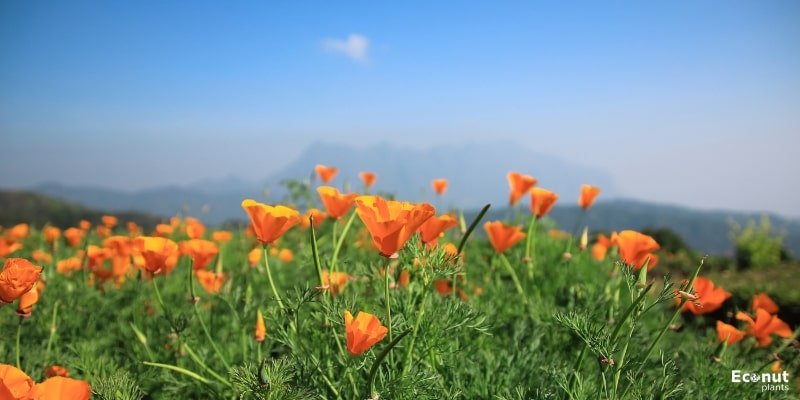
Scientific Name: Chaenomeles speciosa ‘Orange Storm’
Plant Type: Deciduous shrub
Plant Size: 3-4 feet tall and wide
Sun Exposure: Full sun to partial shade
Orange Storm is a flowering quince, a deciduous shrub. It produces rich scarlet or reddish-orange flowers that resemble camellias in early March. The shrub is spherical, wide, thick, and thornless. When the blooms bloom, they do so copiously, and they are typically around 2 inches in diameter.
The oval-shaped leaves have a deep, glossy green colour. This shrub should only be thinned enough to take on the preferred shape; avoid pruning it excessively. Additionally, pruning aids in preparing the shrub for growth in the upcoming season. Eliminate any root suckers right away.
4. Apricot Queen
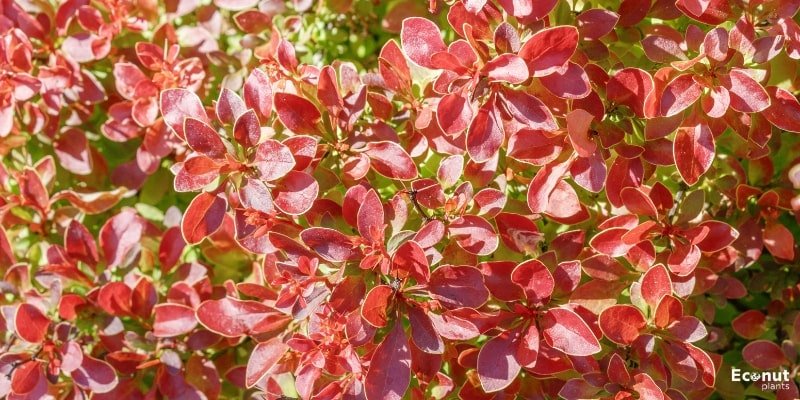
Scientific Name: Berberis x lologensis ‘Apricot Queen’
Plant Type: Evergreen shrub
Plant Size: 10 ft wide
Sun Exposure: Partial to full sun
One of the most exquisite shrubs with orange blossoms is the apricot queen, in particular. This hybrid, which is native to Argentina, exists naturally in the environment. The Apricot Queen has fruit in the summer, and its blossoms are a seductive apricot-orange colour.
When grown as a specimen shrub in a shrub or mixed border, the plant reaches its maximum potential. This plant prefers moist, fertile, and well-drained soil to grow. For the Apricot Queen, partial shade to full sun is ideal.
5. Cigar Plant
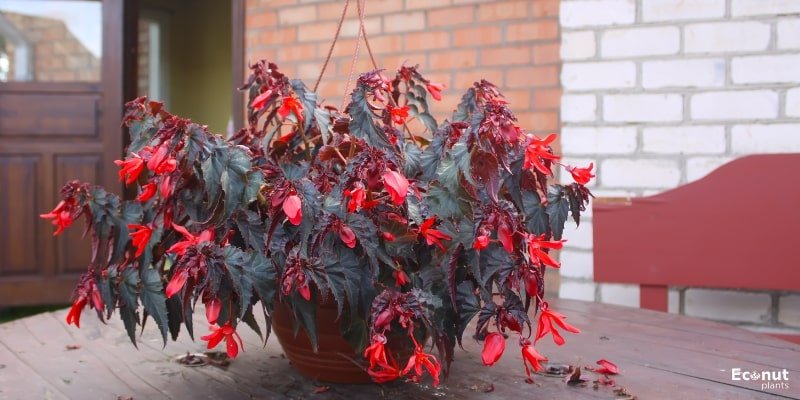
Scientific Name: Cuphea ignea
Plant Type: Evergreen shrub
Plant Size: 10-20 feet tall and wide
Sun Exposure: Full sun to partial shade
The cigar plant is a bushy, spherical, evergreen shrub that can grow to an amazing height of 10 to 20 feet. The vivid orange-red blooms, which grow in tubular forms, draw hummingbirds and butterflies. Every few years, as the original plants start to lose their vigour, you’ll probably need to take some cuttings or start over from seeds.
This plant looks best as a border shrub or bedding plant in the front. Because of its small size, it may be cultivated in containers that will brighten your patio, balcony, or terrace. Remember that cigar plants have a short lifespan, even when cultivated as perennial shrubs.
6. ‘Empire’ Hibiscus
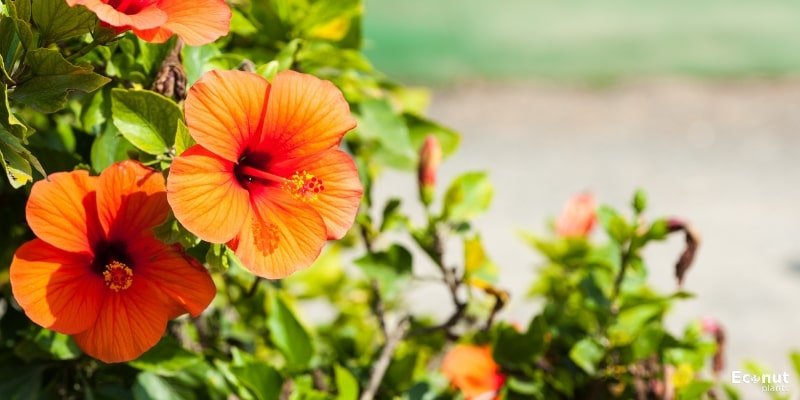
Scientific Name: Hibiscus rosa-sinensis ‘Empire’
Plant Type: Evergreen shrub
Plant Size: 6-8 feet tall
Sun Exposure: Full sun
A variety of hibiscus varieties, like the eye-catching orange summer blooms of the Empire Hibiscus, may lend a tropical feel to any landscape. Their orange-red hibiscus should ideally be planted near patios, in courtyards, and at entryways. In certain spots, the plant’s beauty melds with the blossoms below and the vines above.
Its dense, glossy leaves make this orange hibiscus type suitable for creating a sturdy screen or hedge. Birds, butterflies, and bees are drawn to this plant. An average amount of irrigation is required for this shrub. It enjoys consistently warm conditions and most habitats year-round because it is native to the tropics.
7. ‘Klondyke’ Azaleas

Scientific Name: Azalea x ‘Klondyke’
Plant Type: Evergreen shrub
Plant Size: 6-8 feet tall
Sun Exposure: Full sun to partial shade
An evergreen shrub, the Klondyke Azaleas blooms yellow-orange in the springtime and has dark green foliage. This choice offers captivating solitary golden blooms with a touch of bronze and green foliage. Because of their mounding appearance, Klondyke azaleas make striking landscape accents around reflecting pools or shrub borders.
8. Bird of Paradise

Scientific Name: Caesalpinia pulcherrima
Plant Type: Semi-evergreen shrub
Plant Size: 10-16 ft tall
Sun Exposure: Full sun
A well-known shrub, Bird of Paradise, is sometimes mistaken for other shrubs with similar names that have yellow, red, or white flowers. Though it typically grows to a height and width of around 10 feet, this shrub can reach as high as 16 feet in Hawaii. The Bird of Paradise is tolerant of light to moderate freezing temperatures and dry weather.
When it becomes cold, you may notice that this plant fades into the ground. However, it will rebloom in April or May. The leaves have a vivid green hue and measure about 40 centimeters in length. Each of the racemes of flowers contains either red, orange, or yellow petals. It requires only moderate watering and full sun to flourish.
9. Chicklet Orange Esperanza

Scientific Name: Tecoma fulva
Plant Type: Deciduous shrub
Plant Size: 3-6 feet tall
Sun Exposure: Full sun to partial shade
Vibrant orange flowers that resemble trumpets are produced by this plant from spring through autumn. Due to its dwarf habit, you may easily put this plant anywhere in your garden. This flower also has a light scent.
Pollinators, hummingbirds, and butterflies are all drawn to the Chicklet Orange Tecoma Esperanza. These blooms are surprisingly heat- and drought-tolerant once they establish themselves. This shrub is best planted in a large landscape or flower garden. It can be cultivated in containers in cooler locations and brought indoors for the winter.
10. Flame Azalea

Scientific Name: Rhododendron calendulaceum
Plant Type: Deciduous shrub
Plant Size: 4-8 feet tall
Sun Exposure: Partial sun
The flaming azalea is a slow-growing plant with a harsh texture. With an upright growth habit, this deciduous shrub reaches heights of 4 to 8 feet and widths of 8 to 10 feet. The plant yields 2-inch flowerheads that might be pink, crimson, orange, apricot, or salmon.
The green leaves in your garden will turn yellow as autumn approaches, bringing even more colour. Moisturizing, well-drained soil with some shade is preferred by flame azaleas. These bushes can withstand dryness and grow well with a few hours of direct sunlight.
11. Golden Slippers

Scientific Name: Rosa’ Golden Slippers’
Plant Type: Deciduous shrub
Plant Size: 2-3 feet tall and wide
Sun Exposure: Full sun
Every Boston has twenty petals on its golden slipper blossoms, which are aromatic and colourful. This plant is a hybrid rose shrub; as it ages, the double flowers open into a flat shape and change from vivid orange to pale orange. This plant blooms for a long time; it starts to bloom in the summer and continues until late October.
Golden slippers are ideal for bordering a front flower bed or rose garden because of their spreading growth habit and potential height of two feet. The orange blossoms and the green leaves make a striking contrast. All things considered, this particular species of rose bush is a hardy plant that deters mildew.
12. Lantana
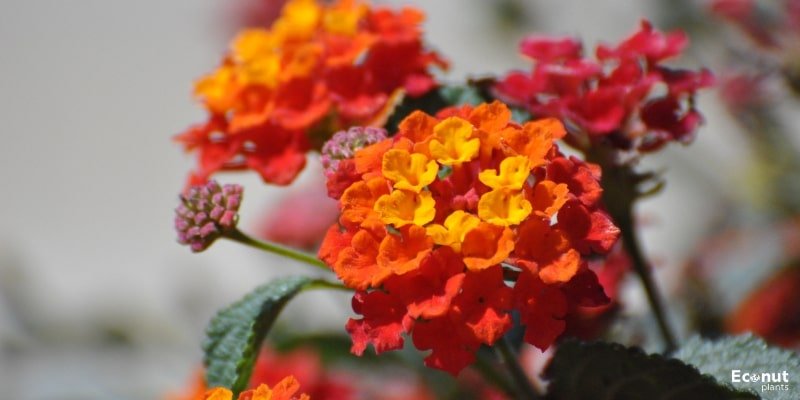
Scientific Name: Lantana camara, Lantana montevidensis
Plant Type: Evergreen shrub
Plant Size: 1-4 feet tall
Sun Exposure: Full sun
Evergreen shrubs that can reach a height of four feet are called lantanas. They can also trail or spread. In the summer and fall, these plants will bear vibrant, multicoloured clusters of 2-inch flat-topped tubular blooms. Evergreen shrubs with large leaves are called lantanas.
These plants are usually low-growing shrubs that require lots of sunshine and a warm climate to flourish. People who live close to the ocean often choose lantanas because of their exceptional resistance to salt spray. Lantanas are frequently found growing in hanging baskets and are generally planted as annuals in cooler climes.
13. Mexican Sunflower

Scientific Name: Tithonia rotundifolia
Plant Type: Annual, perennial, shrub
Plant Size: 4-6 feet tall
Sun Exposure: Full sun
The Mexican sunflower is an annual plant. It has beautiful flowers and grows to a height of around 6 feet. The vivid yellow centers of these electrifying orange blossoms entice butterflies and bees to visit your yard. There are two complete flowering seasons each year.
Flowers are at their best in the summer. The optimum placement for this shrub is as a hedge or close to the back of your garden. The plant is simple to maintain, resistant to deer, and looks great when combined with other vibrant blossoms. If you’d like, you can deadhead the shrub, as long as it doesn’t get too big. Either way, it will bloom for a long time.
14. Oleander
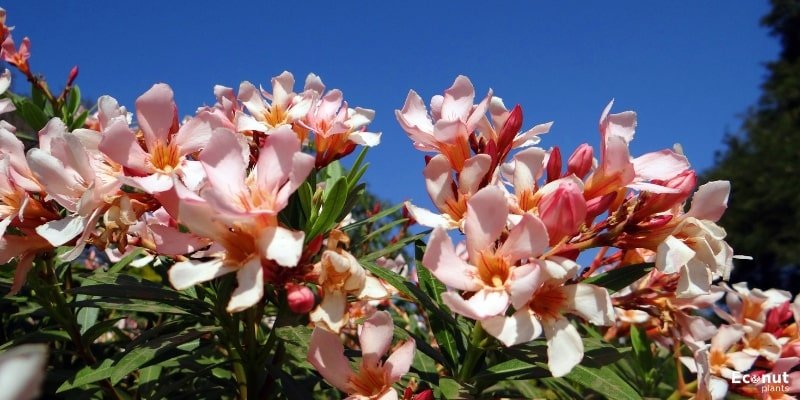
Scientific Name: Nerium Oleander
Plant Type: Evergreen shrub
Plant Size: 3-20 feet tall
Sun Exposure: Full Sun to partial shade
Oleanders are drought- and deer-resistant plants that are prized for their fragrant clusters of apricot-orange blossoms that bloom all summer. With careful pruning, this shrub can grow into a small tree. It grows uprightly. In a spiral arrangement, the leaves encircle the stems.
In addition, the leaves are long and slender, with a pale, crisper texture on the underside and a glossy, green surface on top. There is also a milky sap inside the stems. There are many different colours of flowers, including orange, pink, red, white, and yellow. The bush is poisonous in every way; therefore, proceed with great caution. As a result, keep it away from kids and animals.
15. Pincushion Protea

Scientific Name: Leucospermum
Plant Type: Evergreen shrub
Plant Size: 6 feet tall
Sun Exposure: Full sun
Pincushion proteas are evergreen shrubs native to subtropical Africa with orange flowers that bloom fully in late May. The striking orange blossoms may occasionally be used in floral arrangements. This shrub should be planted in a well-ventilated, sunny, and frost-free environment. In addition to having good drainage, the soil shouldn’t be very rich.
As this plant becomes established, it can withstand droughts. Fertilizer is not necessary either.
Leucospermums can have their bloom time extended if the faded blooms are regularly removed. Only about eight years will pass before the plant dies. But while you have it, it makes a gorgeous focal point in your landscape.
16. Scotch Broom
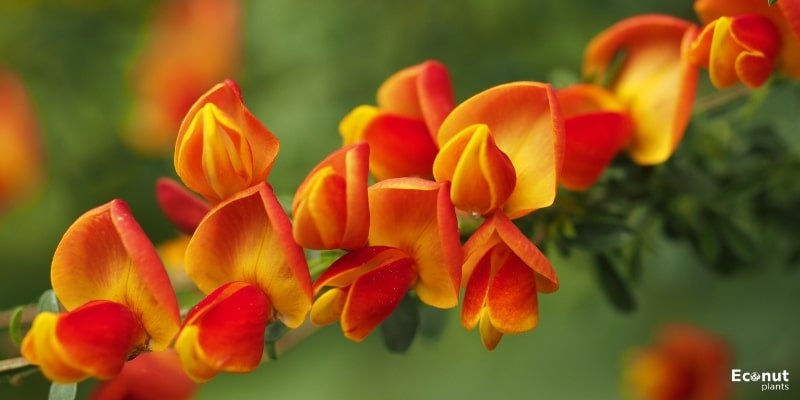
Scientific Name: Cytisus scoparius
Plant Type: Deciduous shrub
Plant Size: 3-10 feet tall and wide
Sun Exposure: Full sun
One of the easiest orange shrubs to grow is the Scotch Broom. It is thick with slender stems and spherical. Pea blooms on each stem might be yellow, white, red, orange, or a mix of these colours. May through June is the flower-blooming season.
The tiny, vivid green leaves give the shrub a pleasant touch. Planting Scotch Broom is a popular choice for cottage gardens. This shrub grows best in dry, sandy places that receive little to no maintenance.
17. Painted Abutilon
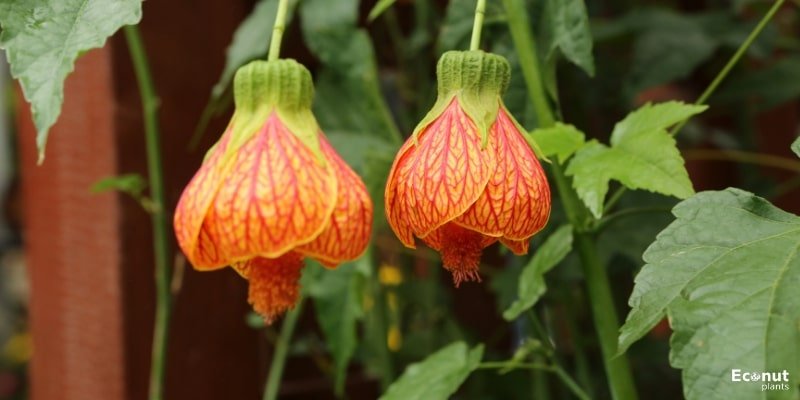
Scientific Name: Abutilon pictum ‘Thompsonii’
Plant Type: Evergreen shrub
Plant Size: 6-8 feet tall
Sun Exposure: Full sun to partial shade
If you’re looking for a delicately coloured, blooming shrub that won’t overtake your garden, the Painted Abutilon is a popular choice among gardeners. It yields bell-shaped blooms with a peach colour. The leaves have a shiny sheen that makes them resemble a maple tree. The leaves also have a faint yellow hue that enhances the plant’s overall appeal.
For these bushes, subtropical climates are ideal. If you’re in zones 9–10, they require ideal illumination. The shrub requires normal watering; also, choose a location that will receive some afternoon shade from the scorching heat. When the plants are young, pinching the tips of the branches keeps the plants compact.
18. Noisette Rose
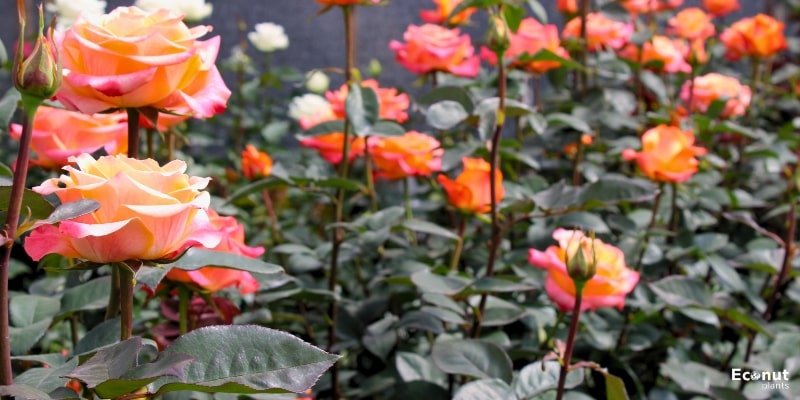
Scientific Name: Rosa ‘Crepuscule’
Plant Type: Evergreen shrub
Plant Size: 12 feet tall
Sun Exposure: Full sun to partial shade
The green leaves of the Noisette rose are lustrous and borne on silky stalks. The orange blossoms have a very subtle scent, and the plant can grow up to 12 feet tall. From spring to the end of autumn, they blossom. This shrub will not thrive in temperatures below 32 degrees Fahrenheit; therefore, if you live in a colder or drier area, you will find it difficult to grow in your garden.
The bouquets may develop little clusters or be solitary blooms. They often continue to flower for long periods, and they have a lovely, mild aroma. If you provide them with enough water and sunlight, they don’t require much upkeep.
19. Lion’s Tail
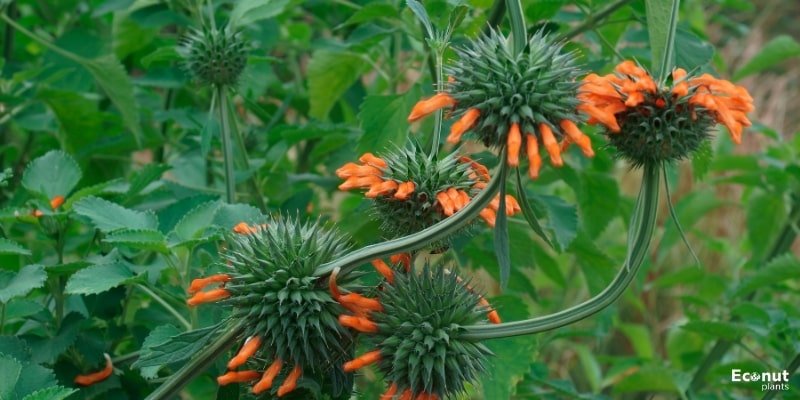
Scientific Name: Leonotis leonurus
Plant Type: Semi-evergreen shrub
Plant Size: 4-6 feet tall
Sun Exposure: Full sun
Gorgeous semi-evergreen shrub Lion’s Tail produces fuzzy, tubular, two-lipped orange blossoms at flowering time. The flowers have whorled tops and upright stems. From late May to November, these stunning flowers begin to bloom. The other Mediterranean and subtropical climate zones are big fans of this shrub.
In milder regions, gardeners cultivate a Lion’s Tail every year, as it can serve as a winter houseplant. This plant adds a stunning accent to your environment when combined with other shrubs that have lavender flowers. Additionally, there are hardly any pests or illnesses.
20. Gibraltar Azaleas

Scientific Name: Rhododendron ‘Gibraltar’
Plant Type: Deciduous shrub
Plant Size: 4-5 feet tall and wide
Sun Exposure: Partial sun
Gibraltar azalea blooms in May with clusters of vivid orange flowers adorned with funnel-shaped ruffles. After ten years, if you don’t prune them for height, they can grow to be five or six feet tall. The height of the plant typically exceeds its width due to its erect growth style.
Deciduous shrubs are Gibraltar azaleas. They are toxic as well. Make sure that kids and pets can’t accidentally consume these plants, so keep them well out of their reach.
21. Flamenco Rumba Cuphea

Scientific Name: Cuphea llavea’ Flamenco Rumba’
Plant Type: Evergreen shrub
Plant Size: 1.5 feet tall and wide
Sun Exposure: Full sun to partial shade
Flamenco is a striking plant that was developed for its vibrant colour show. Its flowering season is long, and its habit is compact. Bright orange-red flower clusters attract hummingbirds in droves. For a more stunning effect, you may include this perennial in window boxes, borders, or even hanging baskets.
Blue-black berry clusters are produced by the Flamenco in the autumn. Its magnificent blossoms, which bloom from spring through autumn, can grow up to 16 inches tall and wide. Over an extended growing season, the compact mounding habit yields a spectacular cluster of blooms.
22. Charles Grimaldi Angel’s Trumpet
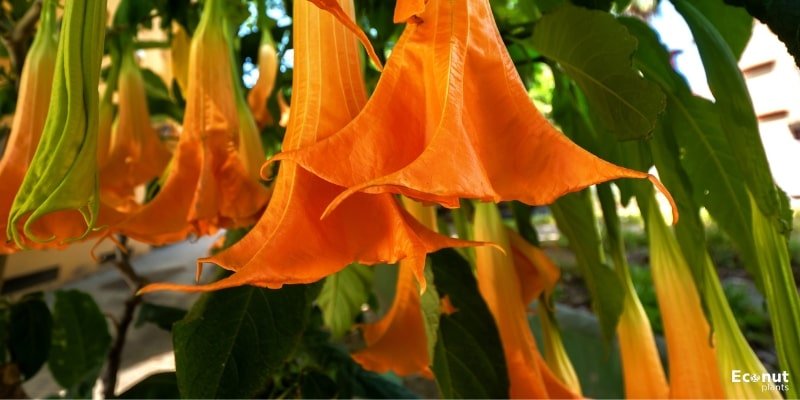
Scientific Name: Brugmansia cubensis ‘Charles Grimaldi’
Plant Type: Evergreen shrub
Plant Size: 8-12 feet tall
Sun Exposure: Full sun to partial shade
Charles Grimaldi Angel’s trumpets are big blooming bushes that produce up to 15-inch-long, pale orange trumpet-shaped flowers in the summer and autumn. When given the correct conditions, this strong and full-sized Brugmansia cultivar can develop from the size of a large shrub to a small tree to an astonishing 12 feet tall. It also boasts big, green leaves.
Their borders are distinctly serrated, and in the summer and autumn, they can bear large orange-yellow blooms with recurved petals that are covered in tiny hairs all over them. This plant prefers light to full coastal shadow and watering every other week.
23. Orange King Bougainvillea
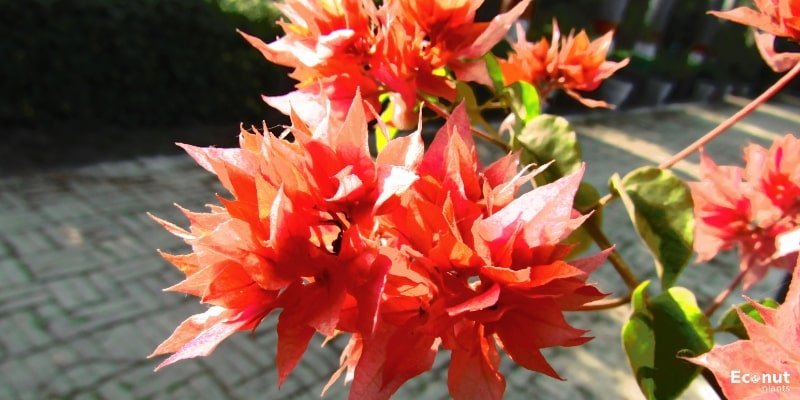
Scientific Name: Bougainvillea x buttiana ‘Orange King’
Plant Type: Evergreen shrub
Plant Size: 20-30 feet
Sun Exposure: Full sun
One orange-flowering shrub with a vining habit is the orange King Bougainvillaea, which grows well as a shrub with spectacular clusters of bronze-orange blossoms. If you reside in a colder environment, you can grow it as an annual, but in areas without frost, it is an evergreen shrub.
It also looks fantastic in hanging baskets or on a patio. The bracts, which draw bees and butterflies to a small tubular flower inside, are what give the flower its striking colour that most people mistake for the actual flower. If you don’t cut the stems down into a shrub, this plant can grow up to thirty feet tall. Be aware that the stems contain thorns.
24. Compact Coral Barberry
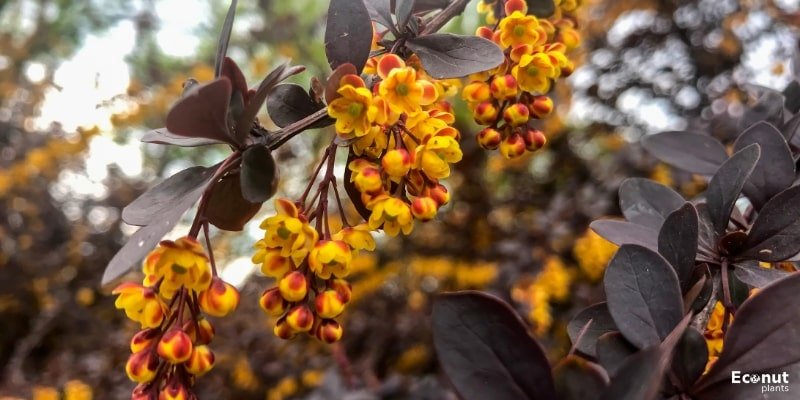
Scientific Name: Berberis x stenophylla ‘Corallina Compacta’
Plant Type: Dwarf evergreen shrub
Plant Size: 1.5 feet tall and wide
Sun Exposure: Full sun to partial shade
A small evergreen shrub cultivar, the Compact Coral Barberry is a member of the Berberidaceae family. The impressive yellow-orange blooms appear in the spring, and the shrub can reach a height and width of around 1.5 feet. Vibrant purple grapes are a fall treat.
All but very heavy, damp clay can be tolerated by this plant. This plant can tolerate little shade, but it prefers full sun. It can be used in rock gardens, pots, borders, foot traffic barriers, and small areas. A bonsai tree can also be made from the compact coral barberry.
25. Firethorns
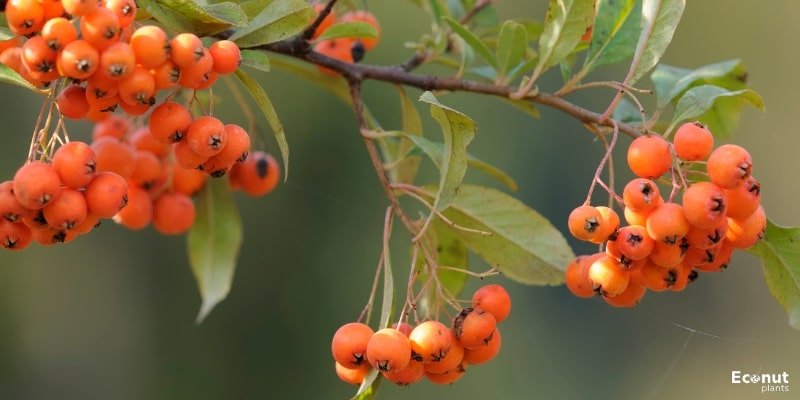
Scientific Name: Pyracantha x ‘Mohave’
Plant Type: Evergreen shrub
Plant Size: 8-12 feet tall and wide
Sun Exposure: Partial sun
Firethorns are fashionable plants that bear clusters of berries in shades of orange, red, and yellow. With its erect growth habits and blooming nature, this evergreen shrub can be trained rapidly against a wall or fence. Since pyracantha belongs to the rose family, you should wear gloves when pruning to shield yourself from the prickly plants.
Firethorns yield a big cluster of white blooms in the spring, which later ripen into vibrant berries that are enjoyed by songbirds such as waxwings and mockingbirds. Look for varieties that are resistant to disease, as this plant is prone to scab and fire blight.
26. Hibiscus Rose
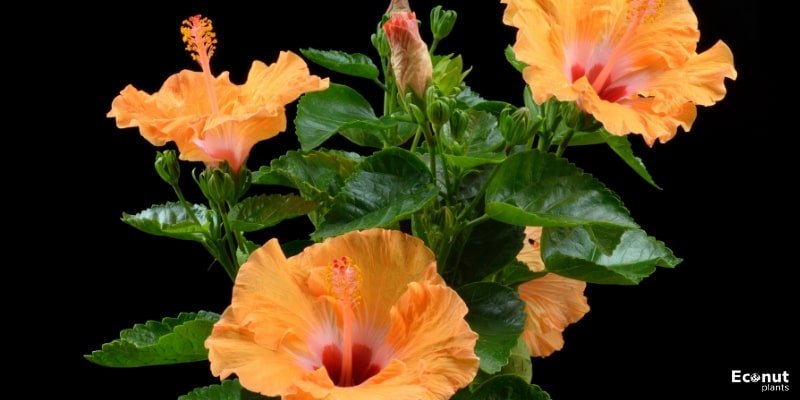
Scientific Name: Hibiscus rosa-Sinensis
Plant Type: Evergreen shrub
Plant Size: 4-10 feet tall
Sun Exposure: Partial or full sun
The enormous, exquisite flowers of the Hibiscus rose, a tropical plant with a high vitamin C content, are well-known. Many people use dried hibiscus flowers in desserts or drink hibiscus tea because of their high vitamin C content. Though most Hibiscus roses are red, some cultivators also sell orange flowers.
The privilege of witnessing hibiscus flowers from summer to autumn will be yours. If you want to maximize development, fertilize during the growing season. The plant will require very little to moderate watering once it is established.
27. Orange Butterfly Bush
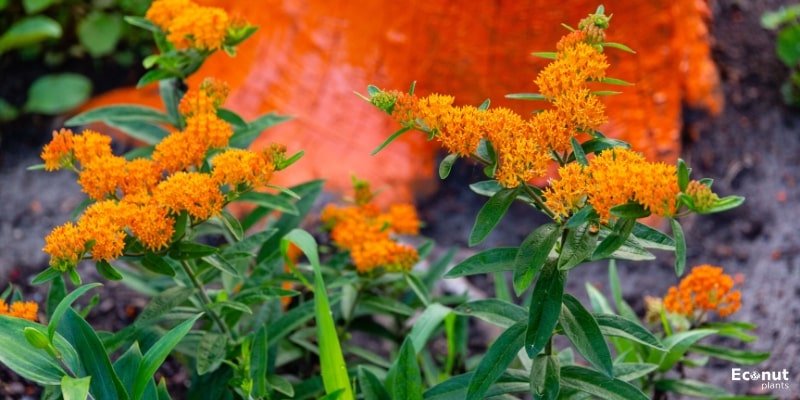
Scientific Name: Buddleia globosa
Plant Type: Semi-evergreen to deciduous shrub
Plant Size: 10-15 feet tall
Sun Exposure: Full sun
The orange butterfly shrub grows quickly and produces fragrant orange blooms that draw attention to themselves whenever someone is in your garden. Measuring roughly 8 inches in width, the blossoms complement red and yellow flowers beautifully.
The deep green leaves, which can grow to be 3 to 8 inches long and have a rich green colour, make a striking contrast with the vivid blossoms. For dry regions, this plant is ideal. They grow well in broad sun and damp, well-drained soil.
After the orange butterfly bush blooms, make sure to trim it to promote new growth for the following season. Their name comes from their propensity to attract butterflies.
28. Orange Peel

Scientific Name: Cestrum ‘Orange Peel’
Plant Type: Deciduous shrub
Plant Size: 3-6 feet tall and wide
Sun Exposure: Full sun to partial shade
The deciduous shrub known as orange peel bears long, tubular orange blooms. If you have yellow plants in your yard, they add a whimsical aspect and a stunning contrast. When the first frost has passed, the blooms remain in bloom until May.
When the sun sets on them, they also release a pleasant scent. They are very easy to maintain and work incredibly well in hot weather. If you reside somewhere that is cooler, you can also grow it every year. But watch out; it’s frost-tender.
29. Potentilla

Scientific Name: Potentilla fruticosa ‘Tangerine‘
Plant Type: Deciduous shrub
Plant Size: 3 feet tall
Sun Exposure: Full sun to partial shade
Potentilla is a great accent for your garden because of the way the lovely orange flowers and the well-placed leaves complement each other so well. The blossoms resemble anemones, and in the fall, when the leaves fall, a reddish-brown bark shows through.
The extended flowering season spans from May through September. To avoid removing the developing shoots, you must prune the shrub with greater precision. For the potentilla plant to thrive, sufficient light and adequate drainage are prerequisites.
30. Rosa Westerland
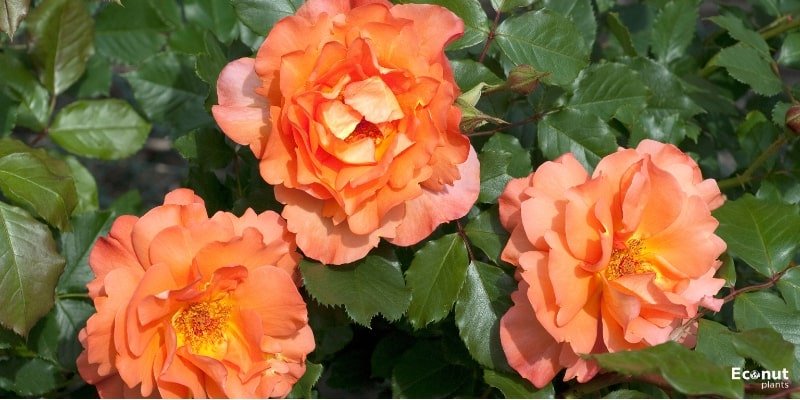
Scientific Name: Rosa’ KORlawe’
Plant Type: Evergreen shrub
Plant Size: 6-12 feet tall
Sun Exposure: Full sun
Depending on where you live in the US, the Rosa Westerland plant may be difficult to locate. A large, orange (brass-coloured) rose with an exquisite scent keeps coming in bunches. This shrub is even more wonderful because it blooms from June through November.
Typically, the foliage is a vivid green that is dense. This shrub thrives in the winter and can withstand lower temperatures. This shrub can be pruned in October or November to keep it resistant to winter. You can cut from the shrub if you’d rather not have the eye-catching blooms.
31. Orange Azalea
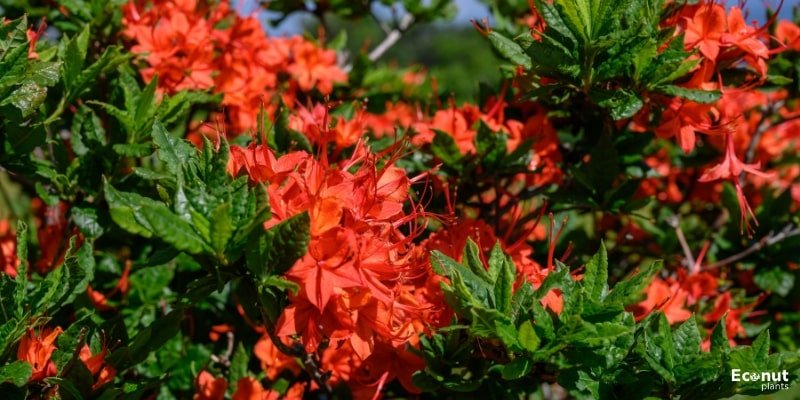
Scientific Name: Rhododendron austrinum
Plant Type: Evergreen shrub
Plant Size: 8-10 feet tall and wide
Sun Exposure: Partial shade
The orange azalea shrub is one of the best choices for your garden if you want to go big and bold. It also goes by the name “rhododendron” because it yields thick foliage and enormous clusters of orange blossoms. All year long, your garden will appear lush and robust, but the blooms will be at their most colourful from March to September.
Additionally, in a bed or along your garden’s edge is the ideal spot. To get the most out of your azaleas, plant them in well-drained, moist soil and give them regular watering as the weather warms from spring through summer.
32. Firebush

Scientific Name: Hamelia patens
Plant Type: Evergreen shrub
Plant Size: 2 to 3 ft. tall
Sun Exposure: Full sun
The fire bush, often known as the Mexican firecracker, is a vivid orange tubular flower that blooms profusely. The vivid orange blooms are borne at the tips of upright stems in forked clusters. The pointed evergreen leaves are six inches tall, and the flowers range in size from one to 1.5 inches. The orange blossoms bloom and are followed by glossy black berries.
Growing two to three feet tall and two feet wide, the fire bush is an ornamental shrub. The orange-flowering shrub is a lovely addition to a landscape, growing well in full sun and wet, well-drained soils. As a screen, hedge, border plant, or foundation plant, it looks fantastic in a sunny garden.
33. Japanese Quince
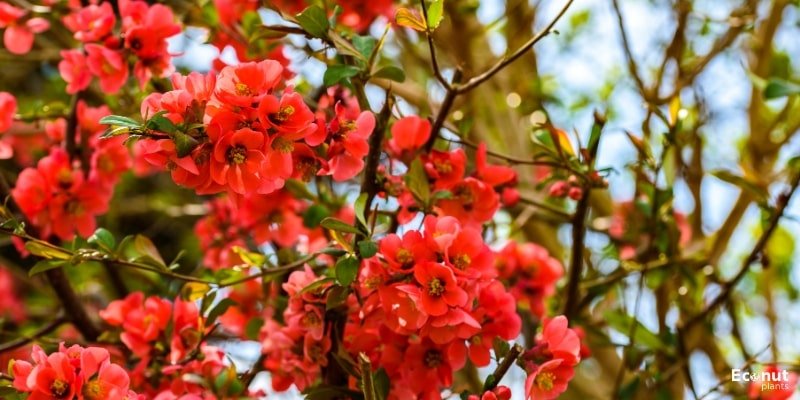
Scientific Name: Chaenomeles japonica
Plant Type: Deciduous shrub
Plant Size: 3 ft. tall
Sun Exposure: Full sun to partial shade
The deciduous Japanese quince is a gorgeous shrub with multitudes of tiny red-orange flowers that blossom along its prickly, widely spreading stems.
Five circular petals with an orange-red colour and creamy yellowish stamens make up each orange flower. The low-growing floral hedge or specimen plant with orange flowers looks great planted along a foundation line.
Conclusion
Any garden would be enhanced by the sight of orange blossoms, which come in a variety of hues, from soft peach to strikingly bright orange. Proper trimming, regular watering, and exposure to light are crucial, regardless of the size of the plant—small shrubs or massive 16-foot-tall monsters.
Certain orange-flowering shrubs on the list require a bit more work to grow, while others, like orange azaleas, are relatively easy. You’ll be happy with any orange shrub from our collection, whether you use it to accent your landscape or cut flowers.

